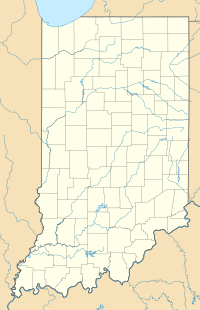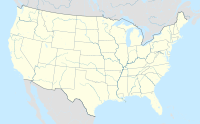Lyles Station, Indiana facts for kids
Quick facts for kids
Lyles Station, Indiana
|
|
|---|---|
| Country | United States |
| State | Indiana |
| County | Gibson |
| Township | Patoka |
| Lyle's Purchase | 1849 |
| Elevation | 400 ft (100 m) |
| Population
(2000)
|
|
| • Total | 401 |
| ZIP code |
47670
|
| FIPS code | 18-45414 |
| GNIS feature ID | 438427 |
| Website | http://lylesstation.org/ |
Lyles Station is a special community in Gibson County, Indiana. It started in 1849, but its first settlers arrived even earlier, in the 1830s. The community was officially named Lyles Station in 1886. It honors Joshua Lyles, a free African American who moved there with his family from Tennessee around 1837.
Lyles Station is unique because it's one of Indiana's first rural communities settled by black families. It's also the only one of these early settlements that is still active today. The community grew a lot between 1880 and 1912. During this time, it had important buildings like a train station, a post office, a lumber mill, two general stores, two churches, and a school. By the early 1900s, Lyles Station had 55 homes and over 800 people.
However, the community faced a big challenge during the Great Flood of 1913. This flood caused a lot of damage, and Lyles Station never fully recovered. Many residents moved away to find better jobs and more education in bigger cities. By 1997, only about 15 families remained, and most of them were descendants of the original settlers.
Even though many similar communities are gone, Lyles Station continues to thrive. The old Lyles Consolidated School building has been restored. It now serves as a local museum and a community center. The Wayman Chapel African Methodist Episcopal Church is another important historical site in Lyles Station.
Lyles Station is even featured in the "Power of Place" exhibition. This exhibit is at the Smithsonian's National Museum of African American History and Culture in Washington, D.C. It opened in 2016 and shows how important black rural communities in the Midwest are. The exhibit includes many items from Lyles Station. These include a horse-drawn plow used by Joshua Lyles, old clothes, a quilt, and soil from a farm that has been worked by the Greer family for over 150 years.
Contents
Exploring Lyles Station's Location
Lyles Station is located in Patoka Township, Gibson County, Indiana. You can find it about 4.5 miles (7.2 km) west of Princeton, Indiana. This area is in the southwestern part of the state. By 1900, the community was bordered by the Patoka River to the north. Old U.S. 41 was to the east, and Indiana State Route 64 was to the south. The Illinois state line was to the west.
Because it's close to the White, Patoka, and Wabash Rivers, Lyles Station is very prone to flooding.
Community Growth and Population Changes
Lyles Station began in 1849, with its first settlers arriving in the 1830s. It was one of Indiana's first black rural settlements. As of 2008, it is the only one still in existence. Two other black rural settlements, Roundtree and Sand Hill, were also established nearby.
Around the turn of the 20th century, Lyles Station reached its peak. It was a busy farming community with about 800 residents. However, after the major flood in 1913, Lyles Station's population decreased. Today, only a few residents and homes remain.
The History of Lyles Station
Lyles Station is named after Joshua Lyles. He was a free African American, born around 1800 in Henry County, Virginia. As a boy, he moved with his family to Montgomery County, Tennessee. Joshua and his wife, Carparta (Clara), moved to Indiana around 1837. Six of their thirteen children were born in Tennessee before they moved.
Some stories say Joshua Lyles was born a slave and became free at age 28. However, newer research using old records from Virginia, Tennessee, and Indiana shows that his family members were free people. This information about him being a freed slave might have come from an Indianapolis News article reprinted in the Fort Wayne Evening Sentinel in 1902.
Early Settlers and Farming Life
Joshua Lyles was one of the first settlers in the community. He arrived around 1837 with his family. The Lyles family bought land near where the White, Patoka, and Wabash Rivers meet. This area is now Patoka Township in Gibson County, Indiana.
In the 1840 census for the township, Joshua and his father, John, were listed. They were two of ten free black men who were heads of households. Joshua Lyles became a successful farmer by 1850. Records show he owned 320 acres (129.5 hectares) of land. His farm produced butter, maple sugar, honey, and Indian corn. Joshua Lyles continued farming and eventually owned 1,200 acres (485.6 hectares). He passed away in 1885. Several of Joshua's siblings and his father also moved to the Patoka Township community by the 1860s.
Community Growth and Development
After the American Civil War, Joshua Lyles went back to Tennessee. He encouraged family friends, free black people, and newly freed slaves to move to Indiana. He also gave land to help the settlement grow. In 1864, Lyles donated land for a school where parents paid a fee for their children to attend.
In 1866, the community received a U.S. post office. This was later replaced by rural mail delivery in 1917. Thomas Cole, another early settler, donated 1 acre (0.4 hectares) of land for the community's first cemetery. In 1870, Joshua Lyles donated 60 acres (24.3 hectares) of land to the Airline Railroad. In return, the railroad built a train station. This station allowed the community to send crops to other areas. It also offered passenger and mail service, which helped the settlement grow faster.
Lyles Station was at its busiest between 1880 and 1912. During this time, it had a train station, a post office, a lumber mill, a school, two churches, and two general stores. The community became officially known as Lyles Station in 1886, honoring Joshua Lyles. By the early 1900s, the settlement had 55 homes and more than 800 people.
The Great Flood and Decline
Heavy rains in the Midwest caused the White, Wabash, and Patoka Rivers to flood in 1913. This terrible event, known as the Great Flood of 1913, destroyed much of Lyles Station. The community never fully recovered from the flood. Most residents left for economic reasons. Farming trends also changed, favoring large farms over small family farms like those in Lyles Station. Former residents looked for safer lives and better job opportunities in bigger cities. By 1997, about 15 families remained, mostly descendants of the original settlers. As of mid-2007, about six families still lived in Lyles Station.
Even though most of Indiana's black rural settlements no longer exist, Lyles Station continues. The community holds yearly reunions. Its group, the Lyles Station Historic Preservation Corporation, works to preserve its history. The National Museum of African American History and Culture in Washington, D.C. features Lyles Station as part of its exhibit on black rural communities in the Midwest.
Learning at Lyles Station: Education
The first school in Lyles Station was a subscription school. Parents paid a fee for their children to attend. It started around 1865, and classes were held in a local church. A three-room schoolhouse later replaced this first school. It was built across the road from the Wayman Chapel African Methodist Episcopal Church.
The Lyles Consolidated School was the third school in Lyles Station. Today, it serves as a community center and museum. Even though the population of Lyles Station decreased after the 1913 flood, a new school was built for the remaining children. Older schools in Lyles Station, Sand Hill, and Sugar Bluff closed as part of a statewide trend to combine schools.
The Lyles Consolidated School opened in 1919. It was an integrated school until 1922, when it became an all-black public school. White students attended Baldwin Heights School in Patoka Township. Lyles Station's school became integrated again in the 1950s. It closed in 1958 because fewer students were attending.
In 1997, the Lyles Station Historic Preservation Corporation was formed. They planned to restore the Lyles Consolidated School. They wanted it to be a local history classroom, a living history museum, and a community center. The school was added to the National Register of Historic Places in 1999. After many years of wear and tear, fundraising and grants helped restore the school building. It is now a place for the community to gather and learn about its history.
Faith and Community: Religion
Two churches were established in Lyles Station: Hardshell Baptist Church and Wayman Chapel African Methodist Episcopal Church. As of 2008, Wayman Chapel AME Church still holds regular Sunday services. It is the only remaining AME church in Indiana that is located in a farming community.
Getting Around: Transportation
The Lyles Station train depot was part of the Louisville-Saint Louis Railroad line. This line was a division of the Southern Railway. The train depot gave the community access to a wider area. Freight, passenger, and mail services helped the settlement grow. Passenger service at the local depot stopped after the community's population declined. A Norfolk Southern railway line still runs along the north side of the area.
Places to Visit: Points of Interest
The restored Lyles Consolidated School building is a community center and local history museum. The Wayman Chapel AME Church is also a key point of interest. These places remind visitors of Lyles Station's heritage as one of Indiana's early black rural communities.
The Gibson Community Foundation helped fund the school building's restoration. The Lyles Station Historic Preservation Corporation also received grants from the United States Department of Agriculture and Build Indiana. They chose two experts in restoration, Architect George Ridgway and contractor Jeffrey Koester, to lead the project.
Famous People from Lyles Station
- Alonzo Fields: He was the first African American chief butler of the White House. He served for 21 years under four presidents.
- Aaron R. Fisher: A World War I veteran, he received the Distinguished Service Cross for his bravery.
- Vertus Hardiman: As a child, he was part of a U.S. government radiation experiment. This left him with a painful skull problem. His story was told in a documentary film called "Hole in the Head: A Life Revealed".
- Matthias Nolcox: He was the first principal of Crispus Attucks High School in Indianapolis.
- Reverend Lyman Parks: He was the first African American mayor of Grand Rapids, Michigan.




